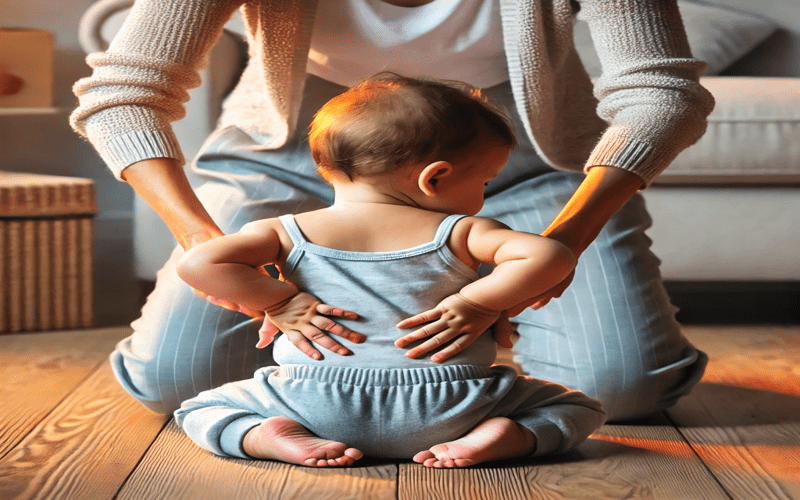
1.Introduction
A baby’s sitting posture plays a crucial role in their spinal development and overall health. While sitting is an important milestone, a baby sitting position bad for the spine can lead to poor posture, muscle weakness, and long-term back issues. Parents should allow their baby to sit naturally when they’re ready, ensuring proper support and movement to prevent spinal strain. This guide covers safe sitting positions, risks of poor posture, and expert-backed tips to encourage healthy spinal alignment for lifelong benefits.
2.When Should Babies Start Sitting?
Babies start sitting with support around 4-5 months and independently by 6-7 months. Signs of readiness include good head control, strong back muscles, and the ability to tripod sit. Forcing a baby sitting position bad for spine can lead to poor posture and weak muscles. Let sitting happen naturally to support healthy spinal development.
Normal Age Range for Independent Sitting (4-7 Months)
Babies usually begin sitting with support around 4 to 5 months and can sit independently by 6 to 7 months. However, rushing this milestone can lead to problems. If a baby sitting position bad for spine, it can cause posture issues and discomfort. It’s important to let babies develop at their own pace to avoid unnecessary strain on their back.
Signs That Your Baby Is Ready for Sitting
Your baby is ready to sit when they show these signs:
Strong neck and head control – They should be able to hold their head steady.
Stable back muscles – Can push up during tummy time without difficulty.
Tripod sitting ability – Can briefly sit while using hands for support.
Shows interest in sitting up – Tries to lift themselves when lying down.
If your baby isn’t ready, avoid forcing a sitting position, as it can affect spinal alignment and posture. Encourage natural sitting to support healthy spine development.
Dangers of Propping Up a Baby Too Early
Placing a baby in a sitting position too soon can be harmful. Here’s why:
Spinal Strain – A baby sitting position bad for spine can cause unnecessary pressure on the lower back.
Delayed Motor Development – Sitting too early can slow down important movements like crawling.
Poor Posture Habits – Babies who sit too soon may develop a habit of slouching, leading to long-term issues.
3.How Bad Sitting Positions Affect the Spine
Poor sitting posture can strain a baby’s spine, causing back pain, weak muscles, and long-term posture issues. Forcing a baby into an unsupported sitting position may lead to spinal misalignment and delayed muscle development. Allowing natural sitting progression supports healthy spine growth and strength.
The Importance of Proper Spinal Alignment in Babies
A baby’s spine is still developing, so proper alignment is essential for healthy growth. When a baby sitting position bad for spine, it can put pressure on the back, leading to discomfort and long-term posture issues. Babies should sit only when they have enough strength to support themselves, ensuring their spine stays in a natural, upright position.
How Poor Sitting Habits Can Lead to Problems
Back Pain in Childhood
If a baby sitting position bad for spine, it can cause early strain on the lower back. Babies who sit too early or in a slouched position may develop spinal misalignment, leading to back pain as they grow.
Poor Posture in Later Years
Bad sitting habits can create long-term posture problems. A baby who frequently slouches or sits in an unsupported position may struggle with rounded shoulders, weak back muscles, and spinal curvature issues later in life.
Weak Core and Muscle Development
Babies develop strength through movement. If they are forced into sitting too soon, they may not build the necessary core muscles for balance and stability. A baby sitting position bad for spine can make them rely on external support rather than developing their natural strength.
If your baby keeps rolling over in sleep and waking up crying, learn why it happens and how to help them sleep better with expert tips for a peaceful night.
4.Common Baby Sitting Positions – Good vs. Bad
Healthy Sitting Positions for Baby
Cross-Legged Sitting (Criss-Cross Position)
This posture greatly supports optimal spinal health. Sitting cross-legged helps babies develop balance, core strength, and proper spinal alignment. It also reduces pressure on the lower back, preventing issues caused by a baby sitting position bad for spine.
Tripod Sitting
In the early stages of sitting, babies often use their hands to support themselves. This tripod position helps them build core muscles and back strength while maintaining a healthy spinal curve. It’s a natural transition to independent sitting.
Supported Upright Sitting
Using an ergonomic baby chair or firm cushions can offer gentle support when a baby is learning to sit. However, keeping their back straight is crucial, as improper sitting posture may cause spinal misalignment and affect development.
Bad Sitting Positions & Their Risks
W-Sitting
Many babies naturally sit in a W position with their legs spread out behind them. However, this can strain the hips, knees, and lower back, affecting spinal alignment. Over time, it can lead to posture issues and muscle imbalances.
Slouched or C-Curve Sitting
If a baby sits with their back rounded in a C-shape, it puts pressure on the spine and weakens back muscles. A baby sitting position bad for spine like this can cause long-term posture problems, leading to discomfort as they grow.
Propping Baby Too Early
Forcing a baby to sit before they are ready can be harmful. When a baby lacks the strength to sit independently, their spine is under unnatural stress, increasing the risk of misalignment. It’s best to let babies sit only when they naturally develop the ability.
5.How to Encourage Healthy Sitting Posture
Allow Natural Development
Babies should not be forced into sitting before they are ready. Sitting too early or in a baby sitting position bad for spine can cause posture problems and strain their back. Instead, let them develop naturally by supporting their rolling, tummy time, and crawling milestones before independent sitting.
Strengthen Core Muscles
A strong core is essential for good posture. To prevent a baby sitting position bad for spine, encourage tummy time, floor play, and gentle movements. These activities help build the back, neck, and abdominal muscles, which support proper sitting alignment.
Use Ergonomic Seating
If using a baby chair, make sure it provides proper lumbar support and keeps the spine in a natural position. A baby sitting position bad for the spine often happens when babies slouch in unsupported seats. Use firm cushions or ergonomic baby chairs that promote upright posture.
Avoid Extended Sitting Time
Babies need frequent movement to develop strong muscles and flexibility. Prolonged sitting in one position may cause stiffness and discomfort. Encourage active play and change positions regularly to support healthy spinal development.
6.Is It Bad to Make a Baby Sit Too Early?
Yes, forcing a baby to sit before they are ready can cause spinal misalignment, weak muscles, and posture problems. A baby sitting position bad for spine can lead to long-term issues, so it’s best to let them develop at their own pace.
How Long Should a Baby Sit Per Day
Babies should sit in short intervals and frequently change positions. Extended sitting can put pressure on the lower back and cause stiffness. Encouraging tummy time, crawling, and floor play helps maintain a healthy spine.
Can Bad Posture in Infancy Lead to Scoliosis
While bad sitting posture alone may not directly cause scoliosis, it can contribute to spinal misalignment and muscle imbalances. A baby sitting position bad for spine can increase the risk of poor spinal development, leading to future posture problems.
Best Baby Chairs for Spinal Support
Using an ergonomic baby chair with proper lumbar support can help prevent slouching. Parents should choose chairs that promote upright posture and avoid seats that encourage a C-curve sitting position, which can strain the spine.
Why Does My Baby Slump Forward While Sitting
Babies slump forward when they lack core strength or are placed in a baby sitting position bad for the spine. Encouraging tummy time, active play, and proper seating support helps strengthen their back and prevent poor posture.
7.When to Seek Medical Advice
Recognizing early signs of spinal issues is crucial for a baby’s healthy development. A baby sitting position bad for spine can cause posture problems, but in some cases, medical attention may be needed.
Signs of Poor Spinal Development
Parents should monitor their baby’s posture. Warning signs include:
Constant slouching – A baby who always sits in a C-curve posture may have weak back muscles or spinal misalignment.
Constant slouching – A baby who always sits in a C-curve posture may have weak back muscles or spinal misalignment.
Uneven posture – A tilted head, leaning to one side, or difficulty sitting upright may signal a posture issue.
If Baby Cannot Sit by 9 Months
Most babies start sitting independently between 4-7 months. If a baby cannot sit without support by 9 months, it may suggest:
Delayed muscle development – Weak core and back muscles can make it hard for a baby to balance.
Underlying medical concerns – In some cases, a baby sitting position bad for spine could be linked to neurological or musculoskeletal issues.
Consulting a Pediatric Physiotherapist
If a baby struggles with sitting posture, a pediatric physiotherapist can help by:
Assessing spinal alignment – Checking if the baby’s spine is developing properly.
Providing exercises – Gentle stretches and strengthening activities to support spinal health.
Correcting posture – Teaching parents how to position their baby safely to avoid a baby sitting position bad for the spine.
Conclusion
Encouraging healthy sitting habits is essential for a baby’s spinal development. Parents should allow natural sitting progression, strengthen core muscles, and use proper support to avoid a baby sitting position bad for the spine. Avoid forcing a baby to sit too early, as this can cause poor posture and spinal misalignment. If a baby struggles with sitting, shows discomfort, or cannot sit by 9 months, consulting a pediatric physiotherapist can help. By focusing on proper posture, movement, and core strength, parents can support their baby’s long-term spinal health.
FAQS
1.Is sitting a baby up bad for the spine?
Yes, if done too early. A baby sitting position bad for the spine can cause poor posture and weak muscles. Let the baby sit naturally when ready.
2.Is it bad to put a baby in a sitting position?
Forcing a baby to sit before they develop core strength can lead to spinal strain and misalignment. Encourage tummy time instead.
3.What is bad for a baby’s spine?
W-sitting, slouching, and unsupported sitting can harm a baby’s spine, leading to poor posture and weak back muscles.
4.How do I know if I hurt my baby’s spine?
Watch for stiffness, discomfort, uneven posture, or difficulty sitting. If concerned, consult a pediatric physiotherapist.
